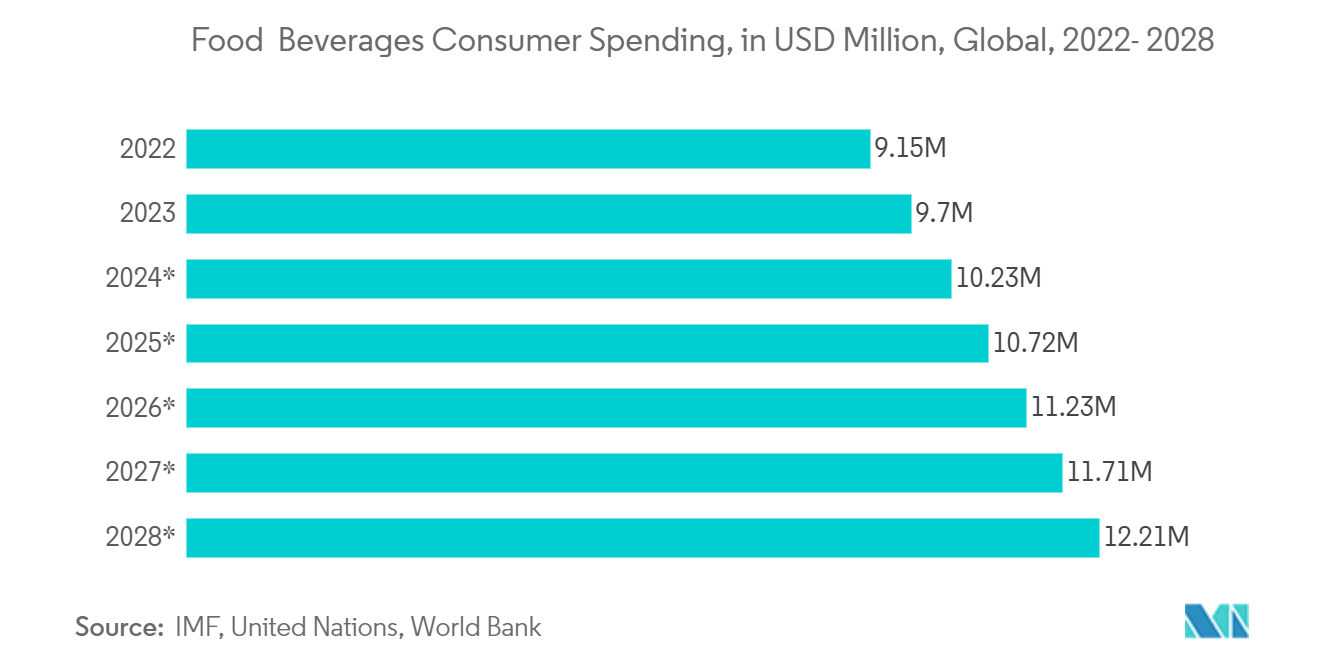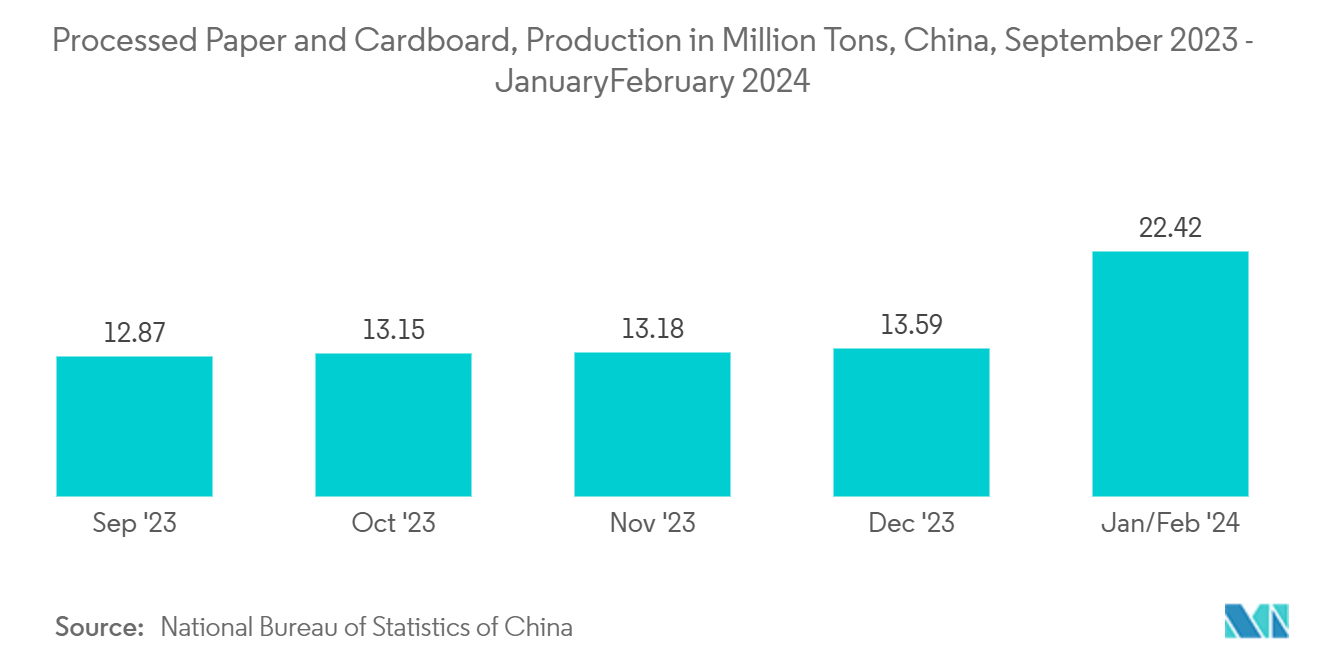Market Trends of Paper and Paperboard Packaging Industry
Increase in Demand from the Food and Beverage Sector
- The growth of e-commerce sales and increasing demand for folded carton packaging in the food and beverage industry are driving the market. According to the International Monetary Fund, consumer spending on food and beverages reached USD 9.5 million in 2022 and is projected to grow to USD 12.21 million by 2026. This upward food and beverage sector trend will boost global demand for paper and paperboard packaging.
- The rapid expansion of e-commerce has significantly increased the demand for shipping and product protection packaging. Concurrently, the food and beverage industry has shown a growing preference for sustainable and recyclable packaging solutions, leading to increased adoption of folded-carton packaging. These factors collectively drive market growth as manufacturers and retailers seek efficient, environmentally friendly packaging options to meet consumer expectations and comply with regulatory requirements.
- Food and beverage manufacturers are intensifying efforts to meet consumer demands for sustainability, performance, accessibility, and healthier food options. This shift is driven by increasing environmental awareness and changing consumer preferences. Sustainable packaging materials, such as biodegradable plastics and recycled paper products, are becoming more prevalent in the industry. Paper bags are gaining popularity in hotels, restaurants, cafés, and other food establishments. These bags offer several advantages, including biodegradability, recyclability, and a lower carbon footprint than plastic alternatives.
- • Many businesses are adopting paper bags as part of their corporate social responsibility initiatives and to comply with local regulations on single-use plastics. The increasing trend of on-the-go meal delivery and online food ordering further drives the demand for paper bags in food services. As more consumers opt for takeout and delivery options, the need for sturdy, eco-friendly packaging solutions has grown significantly. Paper bags provide a practical and environmentally responsible choice for transporting food items, aligning with consumer expectations and industry sustainability goals.
- Consumer preferences drive trends in both beverages and their packaging. Changes in consumer expectations regarding sustainability, customization, and e-commerce have spurred innovation in packaging design and functionality. Sustainability concerns have led to the development of eco-friendly materials and recyclable packaging options. Customization demands have resulted in packaging that allows for personalization or unique product experiences. The rise of e-commerce has necessitated packaging solutions that ensure product integrity during shipping and enhance the unboxing experience for online shoppers. These evolving preferences continue to shape the beverage packaging industry, prompting manufacturers to adapt and innovate to meet consumer needs.
- Primary global food and beverage companies have established goals to make their packaging fully recyclable or biodegradable, responding to consumer preferences. For example, Bacardi announced plans to eliminate plastic by 2030 by developing new paper-based beverage bottles, aligning with the worldwide effort to reduce single-use plastics. This commitment to circular economy principles may lead to further innovations in the paper industry.
- Packaging enhances product authenticity through safety seals and traceability features. Designers use artisanal elements and local imagery to convey product origins. Brands often collaborate with local artists for compelling storytelling. Regional identifiers highlight product provenance. Paper and paperboard, being eco-friendly, are widely used for packaging various food products, including dairy, beverages, dry goods, and fast-food items.

Asia is Expected to Hold Significant Share
- China, one of Asia's largest folding carton packaging markets, is expected to see increased demand due to substantial growth potential in its food and beverage sector. This growth is driven by several factors, including rising urbanization, changing consumer preferences, and expanding retail chains. As a leading manufacturer of processed paper and cardboard, China significantly influences the industry.
- The country's production capacity is crucial in meeting domestic and international demand for folding carton packaging materials. In September 2023, China produced 12.87 million metric tons of these materials, which rose to 22.42 million in January-February 2024. This notable increase in production reflects the growing demand for folding carton packaging across various industries, particularly in the food and beverage sector. The surge in output also highlights China's ability to scale up manufacturing to meet market needs, further solidifying its position as a critical player in the global folding carton packaging industry.
- India, China, Japan, and South Korea are leading countries in the Asia region experiencing rapid industrialization, creating significant opportunities for corrugated packaging manufacturers. The growth of various industries in these countries, such as automotive, electronics, and consumer goods, has increased demand for packaging solutions. Corrugated boxes are widely used across multiple industries, including food and beverage, electronics, and e-commerce.
- Corrugated packaging's versatility and adaptability make it suitable for protecting and transporting a wide range of products. Demand for these packaging solutions is growing in the region as consumers become more environmentally conscious and seek cost-effective packaging options. Corrugated boxes are recyclable and biodegradable, aligning with the region's increasing focus on sustainability.
- The Indian paper and paperboard industry perceives the current transition phase as both an opportunity and a challenge. The sector aims to develop cost-effective and affordable alternatives to meet market demands. Paper mills nationwide are conducting trials to produce paper and paperboard for various applications, including carrying, protecting, wrapping, packaging, and container use. India has recently seen a growing demand for various upstream paper products.
- India has witnessed a substantial rise in paper and paperboard packaging for food and beverages. This increase is driven by growing consumer demand and the entry of new companies into the market. The expansion is primarily attributed to evolving consumer lifestyles, increasing urbanization, and the growth of organized retail in the country. The food and beverage industry has seen a surge in packaged products, ranging from ready-to-eat meals to beverages, all requiring efficient and attractive packaging solutions. The rapid growth of food delivery services, notably Zomato and Swiggy, has substantially contributed to the increased consumption of food and beverage packaging materials. These platforms have revolutionized the way people order and consume food, creating a new segment of packaging demand. The need for takeaway containers, beverage cups, and food-grade paper bags has risen dramatically, driving the growth of the paper and paperboard packaging market.
- Online food delivery platform Zomato announced '100% plastic-neutral deliveries' and set a target to deliver over 100 million orders in sustainable packaging within the next three years. The company plans to collaborate with various stakeholders, including government-led initiatives, social enterprises, and startups, to develop innovative packaging solutions for the restaurant industry.
- The demand for paper pulp is increasing in developing countries, particularly in China, which is the fastest-growing paper per capita consumer. China's paper packaging sector is experiencing growth, driven by the expanding retail and e-commerce industries and increased demand for environmentally friendly packaging products. The rise in online shopping platforms and online shoppers, shifting consumer preferences toward sustainable packaging, and supportive government policies have collectively boosted the demand for paper and paperboard packaging products in the region.
- Japan is a significant consumer of paper-based products across various industries, including newspapers, packaging, printing and communication, sanitary products, and other miscellaneous applications. The packaging sector has seen a shift toward paper usage due to increased consumer awareness about sustainable packaging, concerns over deforestation, and raw material availability, among other factors.
- The paper and paperboard packaging market in Japan is also experiencing steady growth. The increasing demand for beverages and packaged food has driven the need for corrugated packaging in the country. Japan's expanding processed food industry is expected to be a key driver for the paperboard packaging market. Beyond the countries included in the Asia-Pacific region study, other nations such as Taiwan, Malaysia, Singapore, and Vietnam also show significant potential for gaining substantial market share in this sector.


